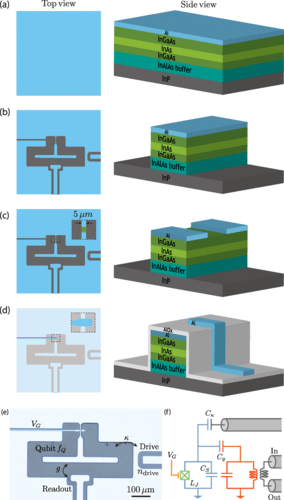Researchers from the Center for Quantum Information Physics, Department of Physics, New York University, and the Institute of Physics, École Polytechnique Fédérale de Lausanne have conducted a study on the tunneling of Cooper pairs across a Josephson junction (JJ). The study, titled “Characterizing losses in InAs two-dimensional electron gas-based gatemon qubits,” presents an alternative approach using hybrid superconductor-semiconductor JJs for constructing superconducting qubits, amplifiers, and other quantum circuits. The team also explored the loss mechanisms in these materials and suggested future directions for enhancing the relaxation times of qubit devices.
What is the Study About?
The study, “Characterizing losses in InAs two-dimensional electron gas-based gatemon qubits,” was conducted by a team of researchers from the Center for Quantum Information Physics, Department of Physics, New York University, and the Institute of Physics, École Polytechnique Fédérale de Lausanne. The research focuses on the tunneling of Cooper pairs across a Josephson junction (JJ), a phenomenon that allows for the nonlinear inductance necessary to construct superconducting qubits, amplifiers, and various other quantum circuits. The researchers present an alternative approach using hybrid superconductor-semiconductor JJs, which can enable superconducting qubit architectures with all-electric control.
What are the Key Findings?
The researchers present continuous-wave and time-domain characterization of gatemon qubits and coplanar waveguide resonators based on an InAs two-dimensional electron gas. They show that the qubit undergoes a vacuum Rabi splitting with a readout cavity and they drive coherent Rabi oscillations between the qubit ground and first excited states. The team measured qubit relaxation times to be T1 100 ns over a 15 GHz tunable band. They also detail the loss mechanisms present in these materials through a systematic study of the quality factors of coplanar waveguide resonators.
What is the Significance of the Superconducting Qubit?
The superconducting qubit is a solid-state system that displays quantum coherence and strong light-matter coupling. Recently, the coherence times of planar transmon qubits have exceeded 300 μs, and further improvements are expected with improved materials and fabrication. A common design choice is to introduce flux tunability of a qubit or coupler for fast, high-fidelity single-qubit control and two-qubit gates. However, an architecture based on flux-biased SQUIDs may lead to future complications. Therefore, an all-electric tunability scheme may prove to be beneficial in large-scale quantum processors, and JJs based on hybrid superconductor-semiconductor materials are one interesting candidate to realize this.
What is a Hybrid Superconductor-Semiconductor Josephson Junction Device?
A hybrid superconductor-semiconductor Josephson junction device has current flow facilitated by Andreev bound states in the semiconductor weak-link. By biasing with an applied gate voltage, one can tune the Fermi level in the semiconductor and the occupation of Andreev bound states, effectively controlling the conduction through the junction. InAs makes an excellent candidate for the semiconductor in a hybrid superconductor-semiconductor junction because it makes an Ohmic contact with superconducting metals such as Al.
What are the Challenges and Future Directions?
While the prospect of using the voltage-tunable junction in tunable couplers between qubits to implement low power, fast two-qubit gates could lead to a near-term potentially useful and interesting material platform to study and integrate with state-of-the-art superconducting qubits, there are challenges. Enhancements in coherence times of gatemon qubits based on an InAs 2DEG have been slow in recent years, mainly due to difficulties in device fabrication. Therefore, it is useful to consider new ways to fabricate InAs 2DEG-based gatemon qubits using simplified fabrication procedures and analyze their effects on fabrication yield and device performance.
What are the Key Observations in the Study?
In the study, the observed qubit frequency is tunable over 1.5 GHz, and the qubit undergoes a vacuum Rabi splitting with the readout resonator. Coherent Rabi oscillations are driven between the ground and first excited states of the qubit, and by fitting the decay of these oscillations, the researchers find that the characteristic timescale of the decay, TRabi2, is 97 ns. The energy relaxation times, T1, of gatemon qubits over a wide gate voltage range are found with a maximum T1 102 ns, where T1 generally increases with decreasing qubit frequency.
What are the Loss Mechanisms in Gatemon Circuits?
In the study, a systematic analysis of the various loss mechanisms in gatemon circuits, such as dielectric loss from two-level systems and inductive loss, is performed by analyzing quality factors of coplanar waveguide (CPW) resonators. The researchers measure a variety of samples with varying Al film thicknesses and detail the loss mechanisms present in these materials. This systematic study of the quality factors of CPW resonators helps in understanding the loss mechanisms and provides future directions in enhancing the relaxation times of qubit devices on this platform.
Publication details: “Characterizing losses in InAs two-dimensional electron gas-based gatemon qubits”
Publication Date: 2024-04-25
Authors: William Strickland, Lukas Baker, J. Lee, Krishna Dindial, et al.
Source: Physical review research
DOI: https://doi.org/10.1103/physrevresearch.6.023094

